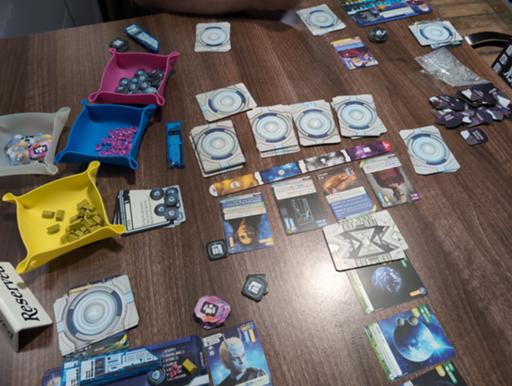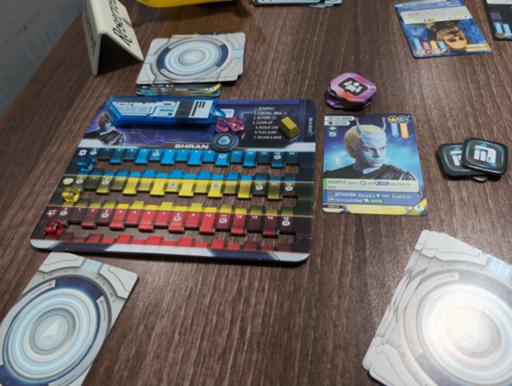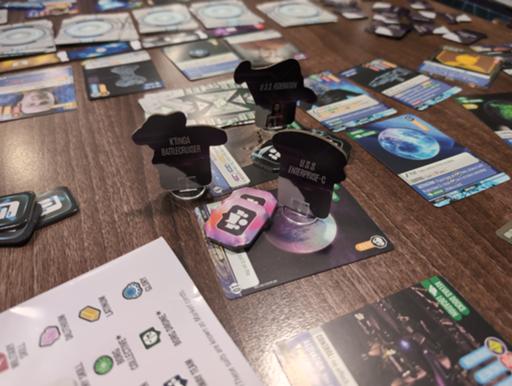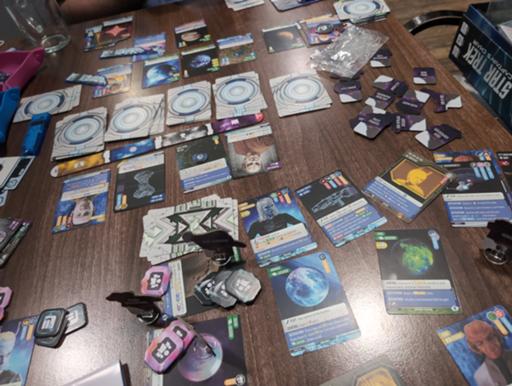After several months of clashing schedules and in one case a
breakdown, back to the boardgame
café.
With just two of us, I'd asked that we try Star Trek: Captain's
Chair,
which is for a maximum of two. And it rapidly became clear while
reading the rulebook that this is basically Imperium, my current
favourite game, given a Star Trek coat of paint and a few tweaks.
You have a starter deck, and every time you reshuffle you include a
card off another deck, and when you run out of those you have more
cards that you can pay to add. There's a market of cards, and at the
end of each turn you put a one-point token on one of them. You can
hide some cards under others to keep them out of circulation and cycle
your deck faster. There are negative value cards which you add to your
deck when you've overreached yourself a bit and try to get rid of
later (but if the deck empties, the game ends at once). It's all
very familiar.

But there are some innovations, and some of them work well. You're not
playing a faction, but rather an individual captain (Picard, Shran,
Sisko, etc.) — though you can still end up with multiple ships.
There's a series of Locations up for grabs, which you get by putting
more Away Teams on them than your opponent can manage. The main decks
are People, Cargo, Ships and Allies. The main game timer is a series
of "stardate cards"; each one has a certain number of Glory tokens,
and when they're exhausted the next one comes into play, or once the
last one is gone the game ends. You have three skill tracks (military,
influence and engineering) and advancing these will give you a higher
score for related cards at the end of the game.

I enjoyed it mechanically, but I felt it wasn't a great match for the
theme. How do I, an Andorian captain, also get control of the
Enterprise-C and a K'tinga battlecruiser? Why is Admiral Necheyev
working for me? How do I have hand phasers when the Federation
apparently doesn't? Imperium makes the common cards that anyone can
use relatively generic ("tyranny", "river valley", "priesthood")
except for the tributary peoples (how did Alexander the Great conquer
the Goryeo, a southern Korean state that existed more than a thousand
years after his death?), but presumably a Star Trek game has to use
the sixty years of accumulated Star Trek lore that it's paid to
licence.

As with Imperium, there's very little you can do unless you have a
card that lets you do it. And while I can see the virtue of that, it
gets frustrating when a thing you can't do is "send another away team
to a planet"; thematically, you could be doing that all the time.

Would I play it again? Certainly. Would I buy it? Almost certainly
not. (Especially since there's already another six-captain box ("To
Boldly Go"), and an expansion with three more ("Second Contact"), and
being me I would want all of them.) But to be fair this did take up
less space than a two-player Imperium, which I don't think we'd have
managed on the standard sub-3-foot Thirsty Meeples table.